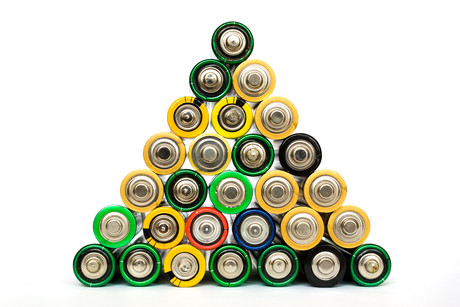How to make batteries that last (almost) forever

This article is part of a series on building the future of batteries. How can we create the batteries we’ll need to power our electronics, transport and industry, and what’s standing in the way?
When a battery runs low it usually needs to be manually recharged, but new approaches are being developed to help this energy source last indefinitely.
Self-sustaining batteries are needed for activities that use sensors. These include long-term tracking of wildlife like flying foxes, multi-year biodiversity assessments in Australian rainforests and the Amazon, and studying the health of the Great Barrier Reef.
This is where energy harvesting comes in handy.
Energy harvesting allows energy to be collected from the environment – through the sun or vibration, for instance. But just like wind and solar energy used for the electricity grid, energy harvesting for mobile technology provides an intermittent and unpredictable energy supply.
This raises the challenge of how to continuously power these devices when it matters most.
To address the issue, we have designed a software framework that can adapt a device’s sensing and computation tasks based on a forecast of harvested energy. This ensures that the sensor can collect and dispatch the necessary data without running out of power.
Energy neutral operation
Our software aims to help devices operate in an energy-neutral way, so that the battery can last indefinitely or until its recharge cycles are exhausted.
One example is our Camazotz tracking device that we use for researching flying foxes. This device is attached to the animals using collars and collects GPS data to understand their movements. It also has a tiny battery and solar panel to recharge each day.
Our software can predict the likely movement of the animal and energy availability, and use this data to determine suitable schedules for the use of on-board sensors. This ensures that the energy needed for obtaining the GPS samples does not exceed the energy we expect to have available through the solar panels.
This software framework can also be used for consumer devices such as smartphones and wearables. But while there is no hard battery lifetime for this approach, how long the battery lasts will still depend on the maximum number of times the battery can be recharged before dying.
Other researchers are exploring energy-positive sensing. Energy can be harvested from human motion, which can in turn can power a wearable device. But in addition to providing some amount of power, information about human activity, such as whether the wearer walking or running, can be reconstructed from the harvested energy signal.
Protecting the environment from batteries
Of course, there are challenges to having battery-powered devices that operate indefinitely in the wild.
Over time, batteries may leak damaging chemicals such as nickel, cadmium or hydrofluoric acid into the environment, or even catch fire under extreme heat.
When monitoring the health of the Great Barrier Reef with a battery-powered sensor, for instance, any battery-powered device must be fully sealed and insulated from the water.
The development of batteries that biodegrade is an interesting direction that could reduce the environmental impact of large sensing systems. Some researchers are experimenting with dissolvable batteries using silk, skin pigment melanin and salt water solutions for electrolytes.
Animal welfare must also be considered: devices for long-term wildlife tracking must either be light and small enough so that animals can move normally, or have a drop-off mechanism at a set time.
The ethics of batteries that last forever
From a philosophical perspective, creating indefinitely powered devices that can sense, think, and act moves us closer to creating artificial life forms.
Couple that with an ability to reproduce through 3D printing, for example, and to learn their own program code, and you get most of the essential components for creating a self-sustaining species of machines.
Self-sustaining battery-powered devices can also continue to gather data from their environment beyond their intended mission. This could lead to the collection of unintended data that might have privacy or political implications.
No battery is sometimes better
Motivated by the risks of battery-powered devices, some manufacturers have created battery-less sensing devices to eliminate the need for battery recharging and environmental risk altogether.
This opens up new applications, such as placing sensors in human and animal bodies for physiological sensing.
Rather than having a continuous storage of energy, these devices can use near-field radio waves or other nearby energy sources to gather enough power to conduct a limited set of sensing or computing operations on-demand. They are similar in concept to passive radio-frequency identification (RFID), but may provide more information than simply the identity of a tag.
The drawback is that it only works under specific conditions. In particular, it requires that the energy source be within a very short distance of the passive device.
 Energy-sustainability will be vital for applications from animal detection and tracking to shipping and logistics. Companies have already started to introduce value-added services such as sensor-based logistics to deliver real-time information on high-value shipments. Sustainable operation of the sensors will only encourage this trend.
Energy-sustainability will be vital for applications from animal detection and tracking to shipping and logistics. Companies have already started to introduce value-added services such as sensor-based logistics to deliver real-time information on high-value shipments. Sustainable operation of the sensors will only encourage this trend.
Raja Jurdak, Research Group Leader, Distributed Sensing Systems, CSIRO and Brano Kusy, Research Scientist, CSIRO
This article was originally published on The Conversation. Read the original article.
Originally published here.
Soft robot uses magnetic fields to power itself autonomously
Inspired by the movement of manta rays, researchers have developed a small, magnetically powered...
Perovskite 'energy sandwich' could power next-gen solar
Researchers have achieved a new level of control over the atomic structure of halide perovskites,...
Creating the truck of tomorrow
Exploring the technological innovations, infrastructure solutions and emerging delivery methods...





